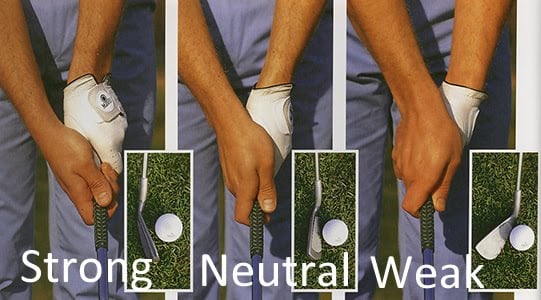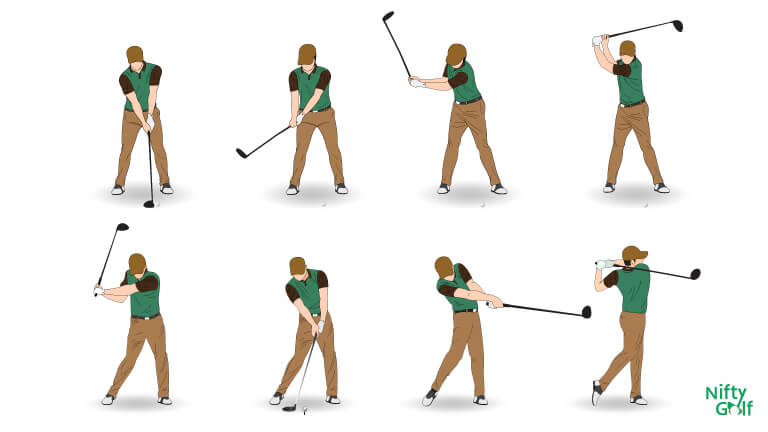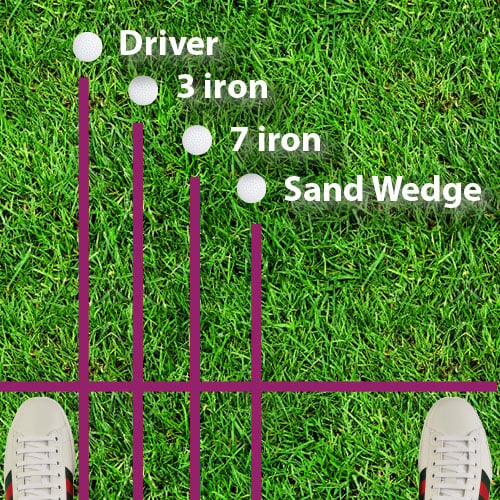“Your today’s score is 99”, this one sentence is enough to light up the whole week. Just 1 stroke less than 100 in the scorecard means a lot to many of us. Though there is a long way to go as we expect you to break 90/80 score next. Your first 2-digit golf score is still very special. It is your first level up in the golf world.
It’s important to mention that beginners usually take 115 or more strokes for 18-hole golf courses. If you are in that range, we suggest having a more short-term target. Focus on being better in basics for healthy growth of your skills with enjoyment.
Usually 108 can be a good golf score for targeting a 2-digit score. So we have structured this article mainly for the golfers ranging from 108 or less. Needless to say, practice is the key for keeping the golf score under 100. Along with that, understanding and following the appropriate process will make breaking 100 in golf a lot easier and faster.
Prepare Beforehand
1. Get the right equipment: Match with your play style
The golf club that pros use to break 80 or your friends used to break 100 may not be a good match for you. You need to choose the equipment that matches your style the most to get the best results on the golf course.
Golf club
Clubhead

Beginners usually struggle to make good contact with the ball. Choosing larger clubheads helps to solve this problem. They offer more forgiveness. According to USGA rules, the largest clubhead size can be 460cc for a golf driver, the longest golf club. Keep in mind that it is better to avoid longer or heavier clubs as it becomes hard to control them. That makes fairway woods or hybrids better choices to strike easily. Since they are shorter in length.
Likewise, a longer golf iron like iron-1, 2 or 3 are usually harder to hit with. You may want to use them to get more distance. But you need to focus more on the control and accuracy for breaking 100 score. That’s why getting shorter irons like iron-4, 5, 6 etc. are better options.
We suggest using cavity back or game improvement irons. They have relatively larger sweet spots and more offset to help the ball go straighter and higher.
Shaft
Graphite shafts: a good option for more distance
Along with the clubhead, the right shaft also contributes to lowering your golf score. Heavy shafts often make it hard to control the swing direction and lessen the distance. Graphite shafts are a good option in that case as they are lighter in weight. Especially the golfers who have shoulder, arm, or hand issues, graphite is a suitable choice. These shafts can increase the distance by 5 yards or more.
The weight range for a graphite shaft is usually 50g- 86g. Whereas, steel shafts usually weigh 90g-120g. Here you need to be careful about the shot accuracy while using graphite shafts. It may sometimes go way too long, in short-distance shots mainly. A good solution is, avoid choosing too light graphite shafts, weighting from 55g or less.
Flex: Avoid XXS and XS
The next task is to pick a flex for your graphite or steel shaft. A very common misconception is that a stiff flex helps to hit farther. It’s just a myth.
Avoid the ‘XXS,’ and ‘XS’ flex for shafts. They are very stiff and suitable for swing speeds above 100 mph or more. You may go for ‘S’ flex which is suitable for swing speeds over 90.
But the better option is the shafts with ‘R,’ ‘M,’ ‘A,’ ‘L’ flex. They provide more distance without you putting much force. They are for golfers with 80 mph- 90 mph swing speed.
Golf ball
Golf balls can make a difference of more than 4 yards. 1 mph increase in the ball speed typically can lead to 2 yards of distance increase on a golf course. This makes it clear that balls can also significantly impact the game too.
You must be thinking how to select a golf ball? There are plenty of things to consider to choose one. To get a combination of both distance and accuracy, golf balls ranging from 60-80 compression rate are a good match. It’s what we suggest you have for a score under 100.
Because the higher compression golf balls, ranging from 80 or more are hard balls. It offers more accuracy and control over the shot. Low handicappers usually use them as these balls require you to hit harder to get distance.
The golf balls with lower compression are better for gaining distance. Generally, golf balls with a 45-70 compression rate are considered lower compression rated balls. When you hit these balls, they easily compress at impact and go farther.
2. What distance to expect?

There is no specific answer to this question. It depends on your game style. What we can do is, let you know what to expect from the clubs on average.
If you have an idea of the distances each club can cover on average on the golf course, it will be easier for you to choose the one to hit with. Have a look at the chart below to understand it better.
| Club | Men’s Average Distance | Women’s Average Distance |
|---|---|---|
| Driver | 230 yards | 200 yards |
| 3-wood | 210 yards | 180 yards |
| 2-iron | 190 yards | Not recommended; 4-wood or hybrid = 170 yards |
| 3-iron | 180 yards | Not recommended; 5-wood or hybrid = 160 yards |
| 4-iron | 170 yards | 150 yards (consider a hybrid, instead) |
| 5-iron | 160 yards | 140 yards |
| 6-iron | 150 yards | 130 yards |
| 7-iron | 140 yards | 120 yards |
| 8-iron | 130 yards | 110 yards |
| 9-iron | 120 yards | 100 yards |
| Pitching wedge | 110 yards | 90 yards |
| Sand wedge | 90 yards | 80 yards |
| Lob wedge | 65 yards | 6 yards |
3. Mental side of golf: an essential yet ignored
The mental side of golf is a significantly less talked about topic among beginners and average golfers. Most of us probably don’t even know that the mental side of golf influences at least 80% of the game. Many pro players see a sports psychologist or mental game coach improve it. It isn’t only about controlling your emotions and thoughts. It’s also about using them to score better in golf.
How to improve your mental game in golf? A few tips for you-
- Make a habit of self-talk to calm yourself down before the challenging shots.
- Breathe. Do box breathing if you can’t calm down with only self-talk. Take the same time to inhale, hold and exhale. If you inhaled for a count of 3, hold it for 3. Exhale for the same. Then, hold for another count of 3.
- Practice under pressure. Give yourself a challenge. Like, you won’t buy your favorite drink for 1 month if you don’t reach your target today.
- Imagine the scenarios of shot results from every angle according to your practice session before striking.
- Don’t think about the past holes. Focus on the present.
- Don’t give up. Keep going when there is 1 % chance of winning.
- Along with the plans, targets, challenges, find a way to enjoy the game. That’s what makes the performance better.
4. Plan your shots
You know what, forget about par as well. You heard it right! Forget about par too.
In 72 par, 27 over par is the least you need to break 100. 13 double bogeys, 1 bogey and 4 pars have the same impact on the scorecard as 9 bogeys and 9 double bogeys. That means you can make a 99 score without even making pars. Target for that.
Before starting, analyze the holes you will be playing. Plan it in your mind. Try to save the double bogeys for the difficult holes. Typically, 5 pars are the easiest to have bogey. You can get close with the first 2 strokes and use 4 more strokes to hole. Keep in mind that par-3 or par-4 are usually harder for a beginner or average golfer to make a bogey as it requires precise shots.
On-Course Steps: Let’s get started!
5. Warm-up: Safety first

The Importance of golf stretching is that every golfer knows. Surely you know about it too. To keep you safe from injuries, it’s a must. It also improves your swing, balance and boosts your confidence. Those are very important while breaking 100 in golf. Know the best ways to do golf stretching to make it work more than before.
6. Golf ball position: Place forward for consistency

The method of correcting the golf ball position is different at different times. A general rule of thumb is to place the ball forward and widen your stance when you take a longer club.
This setup helps achieve the consistency that most golfers struggle to gain, especially the ones near to 100 score.
7. Hold and swing the club properly: Back to basics
Whether it is breaking 100, 90, or 80 score in golf, the basics are most important. We often don’t notice them in the advanced level and mess up the whole game. So, let’s revise once more. No harm in checking, right?
Which style are you following to hold the club? Weak, Strong, or Neutral?

For holding a golf club, you can follow mainly 3 ways to grip the golf club. It’s interlocking or strong grip, neutral grip or baseball grip, and overlapping or vardon grip, which is considered a weak grip.
As you might already know, a strong or weak grip is not about holding the club tighter or loosening it up, it’s the direction of hand placement on the club. You need to have a different grip for different situations-
- Strong or interlocking grip is when the right thumb is facing the same side of the clubhead. And the other way around for left-handed golfers. This grip helps to fix slices as it closes the clubface.
- Weak grip or overlapping, also known as vardon grip, is for those struggling with pull or hooks. To make this grip, put your dominant hand’s pinky finger overlapping in between your other hand’s index and middle finger.
- Baseball or neutral grip is for the golfers whose priority is to transfer more energy to the shot. You need to put both your hands one after another. That’s it. No interlocking or overlapping.
If you are looking for more instructions to hold these golf club grips, you are most welcome to our detailed article on how to hold a golf club.
Now, let’s swing

Grip is the first step to start a swing. Then comes posture, backswing, downswing, and impact. It is a broad topic to understand. You might already know the basics as you are near breaking 100. Thus, we will keep it short. Have a look at the steps to know whether you are doing it right or not.
Step 1: Position your feet wide apart. Bend your knees and hips slightly so that your hand reaches your knees.
Step 2: Keep your hands above the shoulder and rotate your back a little for the backswing.
Step 3: Don’t rush to downswing. Rushing for it is the reason for poor contact and less energy transfer to the ball. Move your hip and shoulder together. Let the lower body lead the swing.
Step 4: Tilt your shaft in the direction of the target at impact.
8. Tee shot: A driver isn’t necessary
Just because everyone else is using the driver doesn’t mean you should do that too. It’s true that a driver helps to drive farther than a wood. Because men’s average distance is 230 yards with a driver and 210 yards with a 3-wood. However, drivers are harder to control for their longer length and lower lofts. It would be rather a disaster if you hit the driver but fail to control it or mess up the accuracy. Here accuracy is more important than distance to achieve a 2-digit score.
In comparison, irons, hybrid and fairway woods have higher lofts that help to make it easier to swing and launch the ball.
How to make a good tee shot? (Step-by-Step)

Step 1: Tee it as the ⅔ of the ball stays higher than the club’s crown. That means the top edge of the clubface will be at the ball’s midpoint.
Step 2: Align the ball with your front foot’s big toe to ensure balance.
Step 3: Drop your shoulder slightly at the address.
Step 4: Keep your wrists flat to transfer more energy to the shot.
Step 5: Extend your arms in V shape.
Step 6: Now strike, keeping your eyes on the ball, and focusing on making correct contact.
9. Fix the slice or use it!
Slice bends to the right in the air for right-handed players and the other way around for lefties. Try to fix the slice first. If you are unable to change it even after many practice sessions, you may simply go with it.
Take a look and try to have an idea how much right or left it goes to on the golf course. Rather than thinking you will be making a straight shot, think about where it will be after the slice. Remember that it is not a good idea to go along with it as it will worsen things in the long run. Why not rather give it a try to fix it? It may not be as hard as many of us consider it to be.
How to fix a slice? (Step-by-step)
Step 1: Adjust the ball according to the shot. Especially for drivers, you need to be more careful as it’s most likely to cause a slice with. Keep the ball slightly inside the left heel for drivers. Pushing the ball a little back from your stance helps make a natural swing.

Step 2: Position the grip mainly on your left hand’s fingers.

Step 3: Don’t open the clubface while striking. For that, rotate the club toe over the heel.
Step 4: While swinging, the weight should move from your back foot to front foot. Then strike.
10. Approach shots: Don’t aim the pin
Don’t aim at the pin if you are more than 50 yards away. Instead, aim for the center of the green. Aiming for the pin kind of means having birdie in mind. When you don’t even need to break 100. You are putting yourself under more pressure for nothing.
By aiming the pin, more chances are that the ball may end up in sand bunkers or water hazards. That will need you to have another extra stroke. It might even result in a triple bogey. Don’t do that. Stick to the plan. Divide the distance on each hole and go for it.
11. Short game: 70% of success depends on this
Most golfers are more focused on having a faster swing speed and more distance. It’s natural to think that more is good. But that doesn’t really work in 70% of golf. Control and consistency over the shot are more dominant. In other words, short game shots are more important.
Knowing how to pitch, chip, and strike flop shots is enough for you to become a master in short game shots. Since we are now focusing on breaking 100 in golf first, exclude flop shots from the list. It’s a difficult one and you won’t be needing it for the time being.
Be clear about when to make a pitch shot and when a chip
Pitch is when you need to make the ball go a little farther on the green. If the grass isn’t good enough for rolling, it’s better to go with pitch shots.
Otherwise, the best choice is to do a low chip shot for a under 100 score. A pitch shot may become a bit risky sometimes as it flies farther than rolling and it may go past the hole. In comparison, the low chip won’t have that risk. It’s, of course, when the grass is short enough to bounce and roll.
12. Try to escape bunkers but don’t fear it!
A bunker shot is a must to break 100 in golf consistently. But a short-cut option is to avoid bunkers as much as possible, especially the deep bunkers. Manage the distance off the tee and hit more carefully.
Sadly, this short-cut is like taking a 50/50 chance. Which is surely something you aren’t into, that’s why you are reading this article till now. So, let’s just learn the correct process. It isn’t that hard. You can do it.
How to strike a bunker shot successfully? (Step-by-step)

Step 1: Take your sand wedge. The one that has a loft of 54° or higher. Here 56° is the standard one.
Step 2: Twist your feet slightly into the sand to keep balance. Align the ball with the middle line of your two feet.
Step 3: Put 60%- 80% of your weight on the front foot. You need to put on more than 65% weight when the sand is wet.
Step 4: Let your arm fall right in front of you and make a V shape.
Step5: Open the face club slightly.
Step 6: Remember that you are not aiming only at the ball but sand as well. As the sand is heavier than grass, it will lose energy and go less than the force you put. Keep that in mind while striking for more accuracy.
Step 7: Bend your wrist a little. Hit slightly behind the ball aggressively, making the ball and some sand come out together.
13. Lag putt: How to avoid a 3-putt?
The lag putts or the long-distance putts sometimes can become really frustrating. Going in one-go is far-fetched for many of us. But it is depressing to take 3-putts or 4-putts, going so close and not making it at the end. Having 3-putts in 5 holes is 15 strokes alone! It’s enough to fail you in breaking 100. A step by step solution is here for you-
Step 1: Practice beforehand
Pendulum Drill: for distance control
Put a tee 30 feet away from the cup. Then, put tees in every 3 feet. Now practice and see how hard you need to hit the ball for a certain distance. Do it on different surfaces to know the effect of the surface too.
Closed Eye: for understanding the perception, rhythm, and feel
Again, put a tee 30 feet away, then place others in every 3 or 2 feet. Close your eyes and hit. Guess how much distance it covered and check it. It will let you know the accuracy of your perception, depending on the feel and rhythm of the hit.
Step 2: Correct your posture
- Bow from your hips.
- Let your hands hang naturally.
- Keep your shoulders and forearms as parallel as possible with the target line.
- Practice a swing before actually hitting the ball.
Step 3: Don’t move so much
- Keep your head and lower body comparatively still. Moving much will affect the accuracy and direction of the putt.
- Try to minimize unnecessary wrist action.
Step 4: Now strike
- Walk on the putt distance and feel if it’s uphill or downhill. Hit soft if it’s downhill and the other way around for uphill.
- Keep the stroke size small for less distance, like less than 3 feet.
Now that you have checked all the steps, enjoy striking every shot. It is good to go according to plans, strategy, and measurements in your head. But don’t let that ruin your love for golf. That’s what is keeping you going. That’s what isn’t letting you give up on the challenge of breaking 100.
Conclusion
Last but not least, keep trying. Having slow progress is okay. Ensure to make consistent efforts. A good idea is to target 106 for the first 2 weeks. Practice throwing 104 in the next 2 and keep lowering the numbers to 102, 100, and then the magical score of 99.
Do you have any confusion? Feel free to comment below.
Also, let us know your progress and targets of the day. We would love to be a part of your journey of breaking 100 in golf.
Happy golfing!

